

The sign of the cross is an important expression of faith and is frequently used during services. In the Eastern Churches, the sign of the cross is made with the right hand. The thumb with the first two fingers are joined at the tip, symbolizing the Blessed Trinity. The remaining two fingers are closed on the palm symbolic of the hypostatic union, i.e. that Jesus Christ is both God and man. The sign of the cross begins with the right hand touching the forehead, then the center of the chest, then the right shoulder, and finally the left shoulder. The sign of the cross is typically made at the mention of the Blessed Trinity, when the priest blesses the congregation, and at the beginning and the end of readings from the Holy Gospel.
A reverence or mytania is made when entering and leaving the church, passing in front of the Holy Table, and in front of the holy icons. The mytania is a symbol of respect and submission to God, comparable to the genuflection done in the Western Churches. The mytania is a bow with the knees kept straight while making the sign of the cross.
When entering and leaving the church, it is customary to approach the tetrapod, make a mytania or reverence, and venerate the icon placed upon it by kissing it. The veneration of icons plays an important role in the Eastern Church. The veneration of icons is directed toward the image represented. Icons are symbols. They allow the faithful to look upon significant events, Divine Beings, and saints not as figures from the past, but as events and personages that are relevant to modern life.
MAIN MENU
Home page - About The Church - About The Brotherhood
Selfreliance Bank - Customs -Vestments - Building
